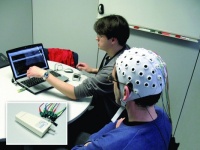
Belgian industrial and academic collaboration Imec, Holst Centre and the lab of neuro- and psychophysiology at the Katholieke Universiteit Leuven recently introduced a prototype of their device dubbed Mind Speller.
The technology relies on a wearable cap that contains electrodes located at specific positions on the user’s head to capture EEG signals. When ready to spell a word and phrase, the user will face a computer or PDA screen that displays rows and columns of letters and characters, similar to a keyboard. An integrated software system then quickly highlights a row or column.
If the letter or character that the user requires is not in the highlighted row or column, a specific brain wave, known as the P300, will be stimulated. These waves are only generated in the brain when someone is shown something different from what the brain expects, explained Marc Van Hulle from the lab of neuro- and psychophysiology at the Katholieke Universiteit Leuven.
’You get an oddball effect,’ said Van Hulle. The brain-wave signals are sent from the electrodes to a electronic processing device that is connected to the cap. The device, which is approximately the size of a matchbox, processes the EEG signals with an ultra-low power eight-channel EEG-chip and digitises them with a low-power microcontroller.
The signals are then wirelessly transmitted by the device’s 2.4GHz radio for computer processing. If P300 waves are detected, the computer program will continue flashing various rows and columns at rapid pace until it has narrowed down the letter or character the user wants.
Once the user is satisfied with the word or phrase formed, an automated voice from the computer or PDA will then be stimulated to speak. While this works reasonably quickly, Van Hulle admitted that the collaborative team is currently developing methods for speeding up the process of interpreting words and phrases from brain waves.
The team has already integrated some time-saving measures such as predictive text, which is similar to the T9 Protocol in mobile phones, into their technology.
Van Hulle said that Imec, Holst Centre and Katholieke Universiteit Leuven are now in the process of forming at least one company for commercialising their technology, which could be ready for market within two years.




Swiss geoengineering start-up targets methane removal
No mention whatsoever about the effect of increased methane levels/iron chloride in the ocean on the pH and chemical properties of the ocean - are we...